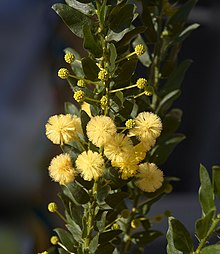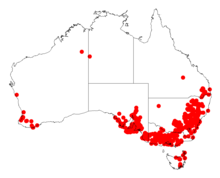
Acacia pycnantha, most commonly known as the golden wattle, is a tree of the family Fabaceae native to southeastern Australia. It grows to a height of 8 m (26 ft) and has phyllodes instead of true leaves. Sickle-shaped, these are between 9 and 15 cm long, and 1–3.5 cm wide. The profuse fragrant, golden flowers appear in late winter and spring, followed by long seed pods. Plants are cross-pollinated by several species of honeyeater and thornbill, which visit nectaries on the phyllodes and brush against flowers, transferring pollen between them. An understorey plant in eucalyptus forest, it is found from southern New South Wales and the Australian Capital Territory, through Victoria and into southeastern South Australia.

Acacia cyclops, commonly known as coastal wattle, cyclops wattle, one-eyed wattle, red-eyed wattle, redwreath acacia, western coastal wattle, rooikrans, rooikrans acacia, is a coastal shrub or small tree in the family Fabaceae. Native to Australia, it is distributed along the west coast of Western Australia as far north as Leeman, and along the south coast into South Australia. The Noongar peoples of Western Australia know the plant as wilyawa or woolya wah.

Acacia saligna, commonly known by various names including coojong, golden wreath wattle, orange wattle, blue-leafed wattle, Western Australian golden wattle, and, in Africa, Port Jackson willow, is a small tree in the family Fabaceae. Native to Australia, it is widely distributed throughout the south west corner of Western Australia, extending north as far as the Murchison River, and east to Israelite Bay. The Noongar peoples know the tree as Cujong.

Acacia ligulata is a species of Acacia, a dense shrub widespread in all states of mainland Australia. It is not considered rare or endangered. Its common names include sandhill wattle, umbrella bush, marpoo, dune wattle, small coobah, wirra, and watarrka.

Acacia acanthoclada, commonly known as harrow wattle, is a low, divaricate, highly branched and spinescent shrub that is endemic to Australia.

Acacia longifolia is a species of Acacia native to southeastern Australia, from the extreme southeast of Queensland, eastern New South Wales, eastern and southern Victoria, and southeastern South Australia. Common names for it include long-leaved wattle, acacia trinervis, aroma doble, golden wattle, coast wattle, sallow wattle and Sydney golden wattle. It is not listed as being a threatened species, and is considered invasive in Portugal, New Zealand and South Africa. In the southern region of Western Australia, it has become naturalised and has been classed as a weed by out-competing indigenous species. It is a tree that grows very quickly reaching 7–10 m in five to six years.

Acacia verticillata is a perennial shrub to small tree native to south eastern Australia.

Acacia lineataA.Cunn. ex G.Don, commonly known as streaked wattle or narrow lined-leaved wattle, occurs naturally inland eastern Australia. The genus Acacia is the largest genus of flowering plants in Australia, containing around 1000 species throughout a diverse range of environments from coast to desert.

Acacia ausfeldii, commonly known as Ausfeld's wattle or whipstick cinnamon wattle, is a shrub species that is endemic to south-eastern Australia. It grows to between 1 and 4 metres high and has phyllodes that are 2 to 7 cm long and 2 to 6 mm wide. The yellow globular flowerheads appear in groups of two or three in the axils of the phyllodes in August to October, followed by straight seed pods which are 4 to 9 cm long and 2 to 4 mm wide.
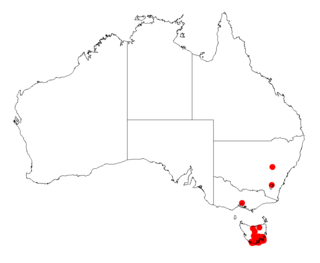
Acacia riceana, commonly known as Rice's wattle, is a small, fast-growing, evergreen shrub to small tree in the legume family endemic to the southeast corner of Tasmania.

Acacia continua, or the thorn wattle, is a shrub belonging to the genus Acacia and the subgenus Alatae. It native to New South Wales and South Australia.

Acacia ramulosa, commonly known as horse mulga or bowgada wattle, is a shrub belonging to the genus Acacia and the subgenus Juliflorae endemic to arid areas of Australia.

Acacia iteaphylla, commonly known as Flinders Range wattle, Port Lincoln wattle, winter wattle and willow-leaved wattle, is a shrub belonging to the genus Acacia and the subgenus Phyllodineae that is endemic to South Australia.

Acacia pentadenia, commonly known as karri wattle, is a shrub or tree of the genus Acacia and the subgenus Pulchellae.

Acacia calamifolia, commonly known as wallowa or reed-leaf wattle, is a shrub or tree belonging to the genus Acacia and the subgenus Phyllodineae endemic to south eastern parts of Australia.

Acacia glandulicarpa, commonly known as the hairy-pod wattle, is a perennial shrub belonging to the genus Acacia and the subgenus Phyllodinea that is native to parts of south eastern Australia.
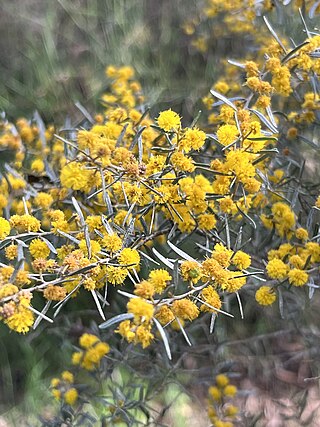
Acacia wilhelmiana, commonly known as dwarf nealie, Wilhelmi’s wattle and mist wattle, is a shrub belonging to the genus Acacia and the subgenus Plurinerves native to the mallee region of central and eastern Australia.

Acacia simmonsiana, commonly known as Simmons wattle or desert manna wattle, is a shrub belonging to the genus Acacia and the subgenus Phyllodineae native to south eastern Australia.
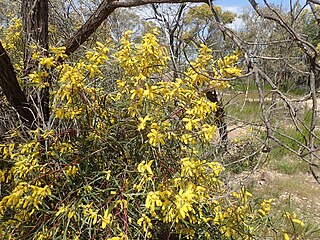
Acacia doratoxylon, commonly known as currawang, lancewood, spearwood or coast myall, is a shrub or tree belonging to the genus Acacia and the subgenus Juliflorae that is native to eastern and south eastern Australia.

Acacia hexaneura, also known as Cowell spine-bush or the six-nerve spine-bush, is a shrub of the genus Acacia and the subgenus Plurinerves that is endemic to parts of South Australia.
